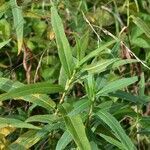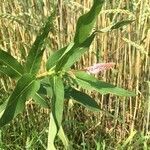A herb which keeps growing from year to year. The stems trail from the base and root at the nodes. In water the stems are hollow which can be 1 m long. The leaves are sword shape and emerge from the water. They clasp the stem. The leaves are more round when floating. The long leaf stalks emerge from a papery sheath. The leaves are dark green and glossy. They taper to a blunt tip and have dark markings near the tip. The flowers are in neat pink spikes.
Perennial herb. Leaves floating; petiolate; blade narrowly ovate, base cordate or rounded, apex acute; glabrous; petioles > 5 mm long. Ocrea without a spreading herbaceous limb; without a fringe of bristles. Flowers: perianth red to deep pink; Sep.-May. Fruit a biconvex nut.
Perennial herb. Leaves broadly elliptic, floating, lamina base rounded, petiole longer than 5 mm. Nut lenticular. Flowers red to deep pink.








